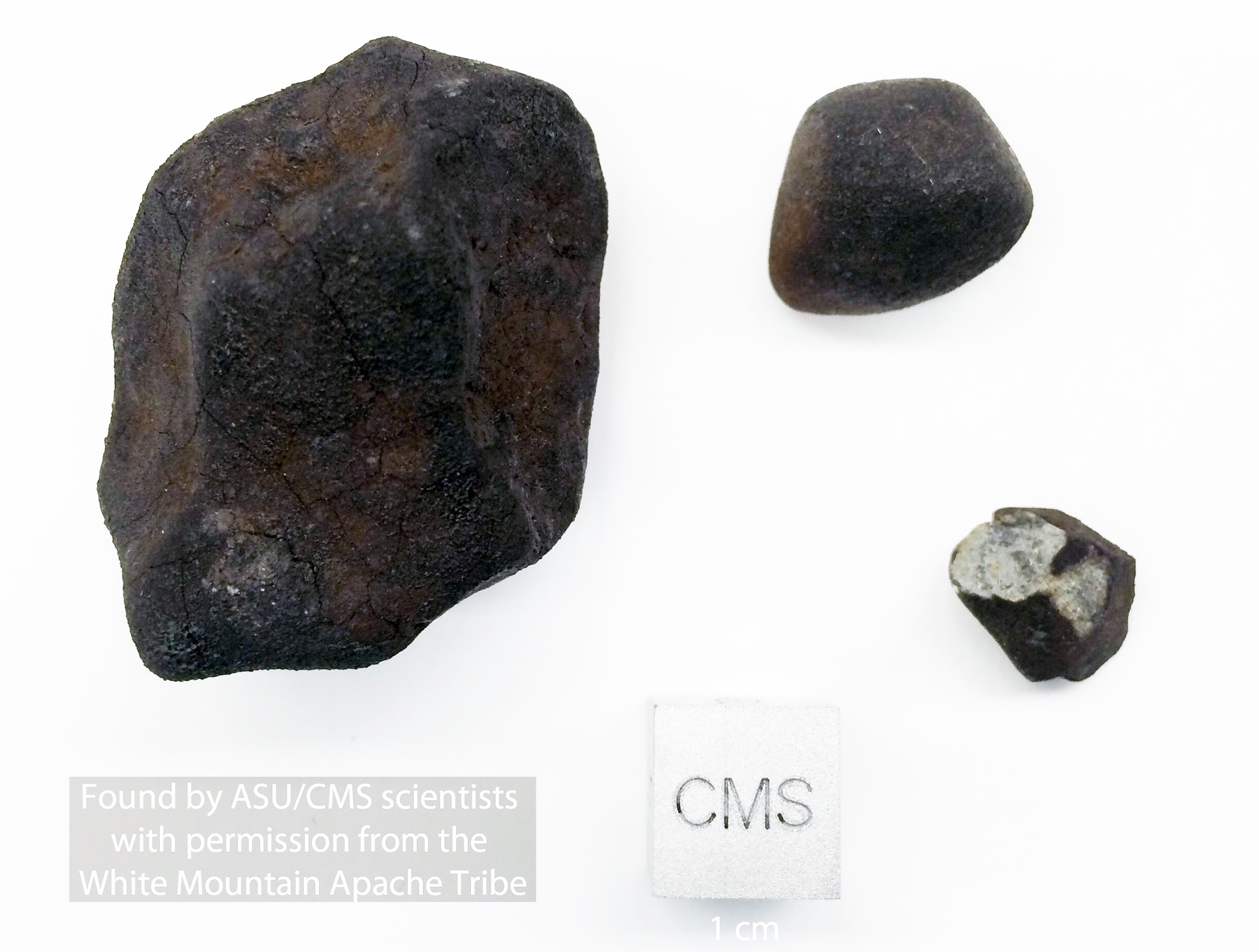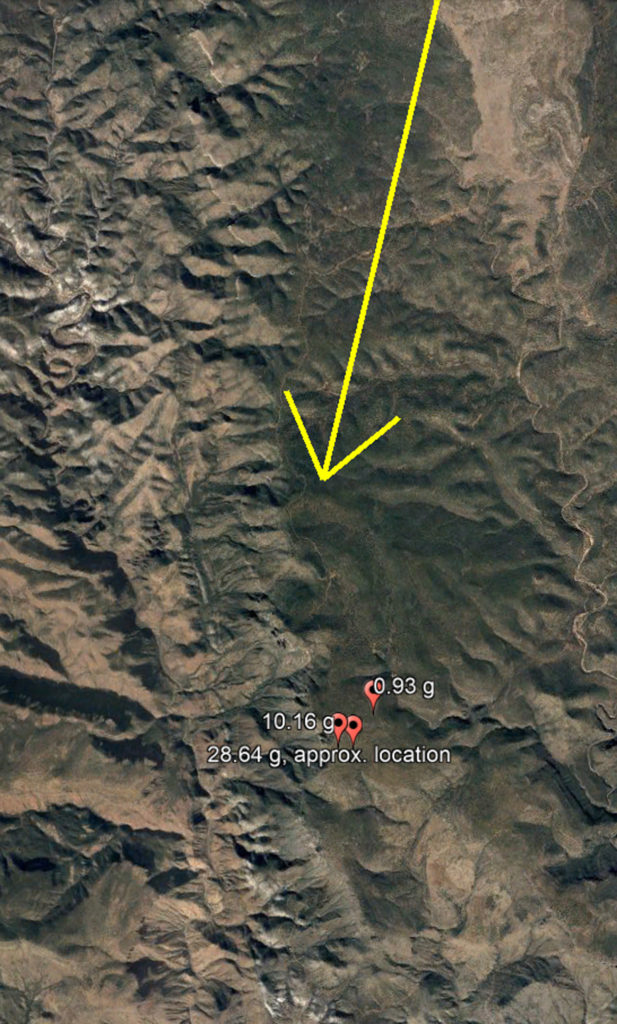Dishchii’bikoh Ts’iłsǫǫsé Tsee
Meteorite fall (LL7, S3, W0) on White Mountain Apache Tribal Land, Arizona, USA on 2 June, 2016, ~10:56:28 UTC
15 meteorites (79.46 g, LL7) of the 2 June 2016 bolide (~10:56:28 UTC) have been found on White Mountain Apache Tribal land, Arizona, USA. On 29 May 2017 Dishchii’bikoh was officially registered as confirmed fall in the Meteoritical Bulletin Database. Dishchíí Bikoh means ‘Horizontally Red Canyon’ (Cibecue) in the language of the Cibecue Apache people and refers to the Salt River Canyon. The meteorite’s full name chosen by the Apache tribe is Dishchii’bikoh Ts’iłsǫǫsé Tsee ♫ (Cibecue Star Stone).
Database entry:
“Dishchii’bikoh 33°53’0.48″N, 110°38’8.20″W
Arizona, USA
Confirmed fall: 2 Jun 2016
Classification: Ordinary chondrite (LL7)
History: (D. Dunlap, M. Fries, R. Garcia, L. Garvie, M. Hankey, R. Matson, P. Mane, M. Miller, R. Ward) At 3:56:34 MST (10:56:34 UTC) on 2 June 2016, a bright fireball was widely observed throughout the southwestern US. The fireball was recorded in imagery from the NOAA NEXRAD weather radar network, on the KFSX radar in Flagstaff, Arizona. Radar reflections consistent with falling meteorite material were first recorded at 10:57:12 UTC at an altitude of 9.7 km above sea level (ASL). Two additional radar sweeps recorded the event, at 11:01:14 UTC (5.1 km ASL) and 11:02:30 UTC (5.1 km ASL). The mass of meteorites for these detections was estimated at 3.7 kg, 2.15 g, and 0.54 g respectively, using M. Fries’ dark-flight model Jörmungundr (v.42) and wind velocity data from a radiosonde launched from Flagstaff at 00:00 UTC. The fireball was also recorded on US Department of Defense orbital sensors, leading to a total radiated energy of 17.2 × 1010 J, with energy equivalent to 0.49 kiloton of TNT. The air-blast shockwave was recorded on the earthquake seismic network from the Payson-Strawberry station. Analysis of the Doppler radar data showed stones likely on the ground on the southwestern corner of the White Mountain Apache tribal (WMAT) lands. With the help of Jacob Moore (Assistant Vice-president of Tribal Relations, ASU), permission was granted by Ronnie Lupe, the WMAT Tribal Chairman, to enter the tribal lands and search for and collect meteorites. Laurence Garvie, Daniel Dunlap, and Prajkta Mane of ASU, and private meteorite hunters Robert Ward, Mike Miller, and Ruben Garcia searched for meteorites starting 22 June 2016. Robert Ward found the first stone, 0.93 g, at 33°53’19.7 N and 110°37’55.0’ W. A total of 15 fusion-crusted stones weighing from 0.9 to 28.6 g, for a total of 79.46 g, were found on 22 and 23 June, 2016. The stones were found along a 1.7 km transect, with a 10.16 g stone found at 33°53’0.48″N and 110°38’8.20″W near the center of the finds, though this location is likely at the small end of a large strewnfield that extends to the SW.
Physical characteristics: (L. Garvie, D. Dunlap, P. Mane, ASU; R. Ward, M. Miller, R. Garcia). Fifteen fusion-crusted stones for a total mass of 79.46 g. Fusion crust is dominantly shiny black, though on two stones it is brown, matte, and powdery. Five of the stones broke upon impact. Interiors are whitish gray, with uneven distribution of darker clasts to 5 mm, and troilite to 3 mm. Stones are dominantly soft with a sugary texture.
Petrography: (L. Garvie, ASU) Pieces of four stones were mounted in epoxy and polished. Sections show a breccia of clasts dominated by granoblastic textures in a cataclastic matrix. Granoblastic areas: areas with this texture occur as rounded clasts with a sharp boundary to the cataclastic material. No easily recognizable chondrules were visible, though one 200-μm-sized grain may be a remnant BO chondrule, and two rounded 500 μm-sized areas with finer-grained pyroxene than enclosing material may represent former PO chondrules. Silicates typically 50 μm, some grains to 300 μm. Troilite and taenite
Geochemistry: (L. Garvie ASU, P. Mane, UAz) Olivine, low-Ca pyroxene, and plagioclase dominate the sections. Microprobe results from the cataclastic and granoblastic regions are the same. Olivine Fa31.0±0.3, FeO/MnO=59.6±3.4, n=14; low Ca-pyroxene Fs25.0±0.3Wo1.8±0.3, FeO/MnO=35.6±2.0, n=9; high Ca-pyx Fs11.2Wo43.1, FeO/MnO=46.6, n=1; plagioclase Ab85.8±1.6An10.9±0.5, n=10; taenite – Ni 50.0±3.1 wt%, Co 1.9±0.2 wt%, Cu 0.18±0.06, n=10; kamacite – Ni 3.7±0.5 wt%, Co 11.8±0.7 wt%, n=10; chromite – Cr/(Cr+Al) = 0.85±0.01, Fe/(Fe+Al) = 0.79±0.03, n=10; and, phosphates dominated by apatites with F 1.1±0.3 wt% and Cl 4.4±0.3 wt%, n=7.
Classification: Ordinary chondrite, LL7, S3, W0.”
The meteorite search
As announced by Arizona State University on 28 June 2016* fifteen meteorites (79.46 g), weighing between 0.9 and 28.6 grams, (ordinary chondrites, LL7) have been found during a 132-hour-search expedition by Arizona State University. The first pea-sized meteorite (0.93 g) was found on June 22 by Robert Ward at location at location 33°53’19.7″ N, 110°37’55.0″ W. The ‘reconnaissance expedition’ was lead by Laurence Garvie who together with ASU’s assistant vice president of tribal relations, Jacob Moore, had contacted Chairman Ronnie Lupe of the tribal council of the White Mountain Apache Tribe shortly after the fall to ask permission to search on tribal land. The search team was supported by tribal chief ranger Chadwick Amos and Game and Fish director Josh Parker. Other team members were Prajkta Mane and Daniel Dunlap, two grad students of ASU’s Center for Meteorite Studies and three private meteorite hunters (Robert Ward, Ruben Garcia and Mike Miller) who had been invited upon condition that they would hand over any found meteorites to ASU. The fifteen found meteorites are property of the White Mountain Apache Tribe and will be curated at ASU. The largest specimen (28.6 g (29.35 g ?)), provisionally named LG2, was found by Laurence Garvie around this location 33°53’01.8″N 110°38’17.9″W on a plateau in the southwestern corner of the White Mountain Apache Reservation. At least one more search expedition is planned. Its goal is to find larger masses to establish a strewn field map. The negotiations between ASU and the tribal council are said to be in progress. The meteorites found so far are on public display at the Center for Meteorite Studies at Arizona State University .
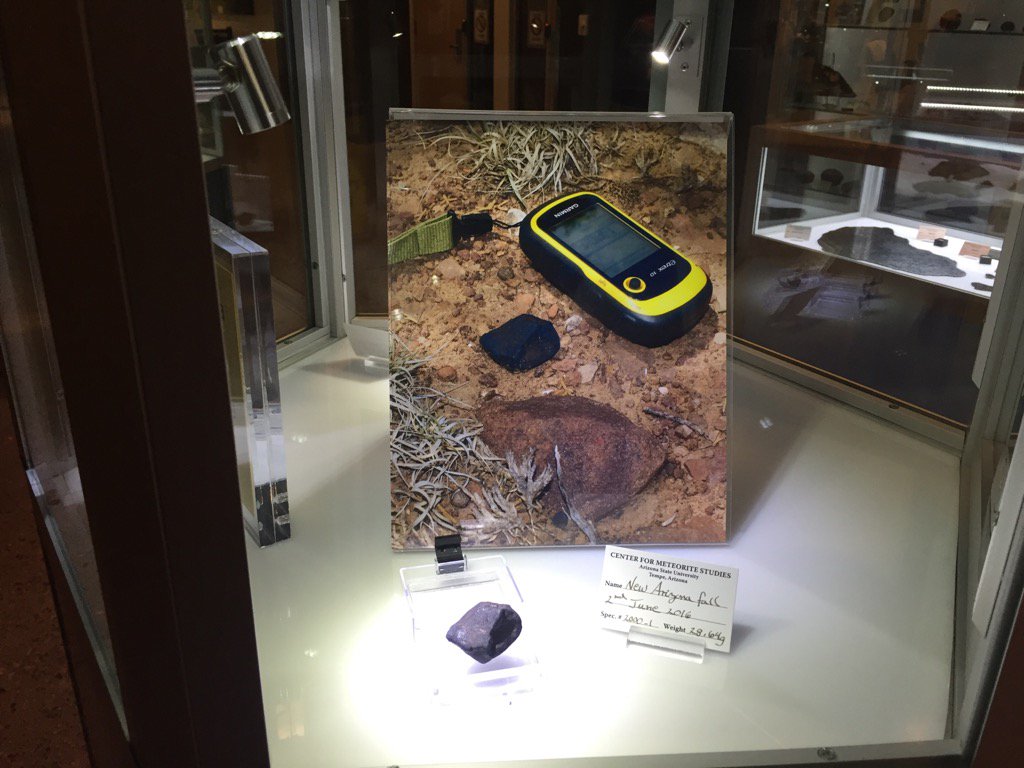
One large specimen (#2000.1 / 28.64 g) found on 2 June 2016 during first expedition on display at the CMS at ASU / Photo: Prajkta Mane
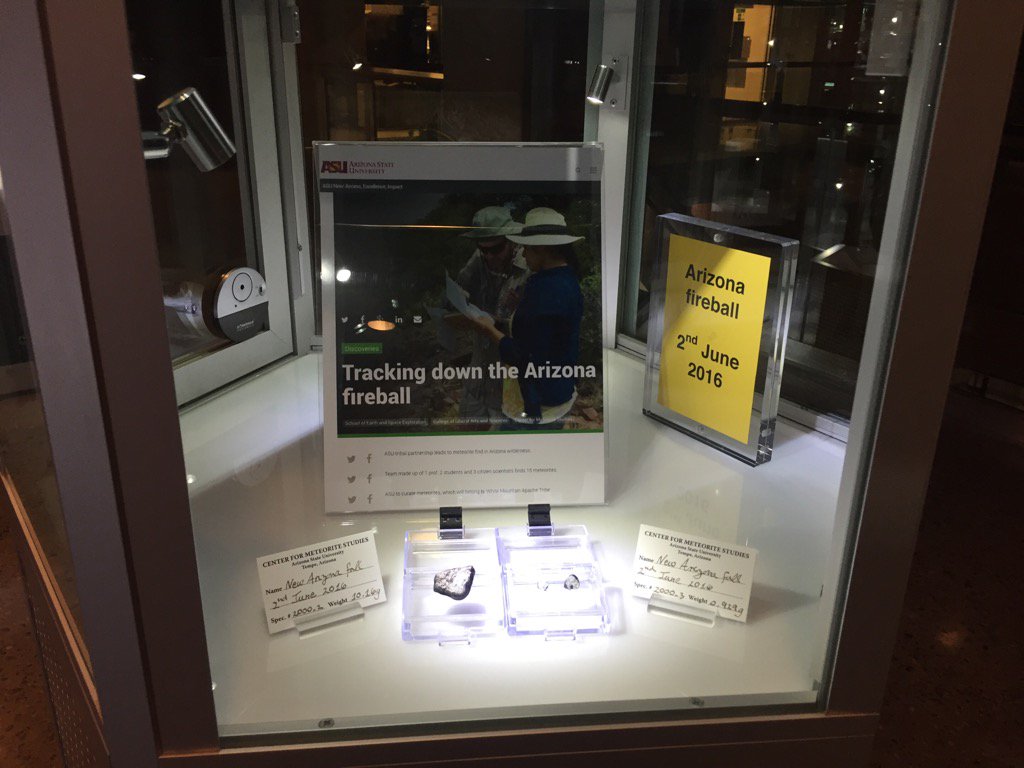
Two specimens (#2000.2 / 10.16 g and #2000.3 / 0.929 g) found on 2 June 2016 during the first expedition on display at the CMS at ASU / Photo: Prajkta Mane

Laurence Garvie, Prajkta Mane, Daniel Dunlap, Robert Ward, Mike Miller and Ruben Garcia. (left to right) / Image: ASU
Pictures of a 10.16 g specimen found by R. Garcia on 23 June , 2016 at location at location 33°53’0.48″N, 110°38’8.20″W: Side A Side B
The specimen appears to be the second largest find of the first search expedition. The third largest meteorite seems to to be a specimen of 9.36 grams.
The bolide
On 2 June 2016 at about 10:56:28 UTC (3:56:28 MST) a large fireball was seen and recorded by hundreds of people above Arizona, USA. According to current publicly available data the bolide reached its peak brightness at 10:56:32 UTC and was initially calculated to have radiated a total energy of 17.2e10 J and have a total impact energy of 0.49 kt. It is assumed that a meteoroid with a diameter of about 1-2 meters, a mass of a few tons and a kinetic energy of approximately half a kiloton entered the atmosphere and passed it with a speed of about 40,200 miles per hour. Based on AllSky-camera recordings of the Lowell Observatory (LO-CAMS) a preliminary trajectory was calculated. The luminous trail started twenty kilometers southwest of Holbrook above location 34.6507 N, 110.4828 W at an altitude of 107.4 km and reached the location above Heber-Overgaard (34.4087 N, 110.5587 W) at a height of 77.2 km. According to the Turkey Spring Observary camera data the bolide lit up four times: at 10:56:31.256 UTC, at 10:56:31.856 UTC at 10:56:32.458 UTC (peak brightness), and at 10:56:32.643 UTC. It’s peak brightness reached an apparent magnitude of -21.8. The bolide’s southbound luminous trail ended after about 7 seconds at a height of about 35 kilometers.
The bolide was recorded by eight cameras of the SkySentinel Allsky Camera Network in Arizona (Turkey Spring, Flagstaff, Parker) and New Mexico (2x Albuquerque, Las Cruces, Los Alamos, Lamy).
On 21 May 2019 another trajectory and orbit analysis* of the bolide by C. Palotai et al. was released, based on three cameras (Flagstaff (Node 6), Arizona ; Payson (Node 79), Arizona; Albuquerque (Node 5), New Mexico) and a multi-spectral sensor observation by the SkySentinel camera network. Additionally, dash cam footage was analysed. According to this analysis the bolide with its pre-atmospheric velocity of 17.4 ± 0.3 km/s, an initial mass of 14.8 ± 1.7 metric tonnes and a diameter of about 2 meters began its luminous trail at an altitude of 100.2 ± 0.4 km above a location with the coordinates 34.555 ± 0.002°N, 110.459 ± 0.002°W. The bolide reached its peak brightness of -20.4 ± 0.2 magnitude after 5.5 seconds at a height of 29.8 ± 0.6 km. The luminous trail ended after 6.2 seconds at a height of 21.9 ± 0.6 km above location 33.924 ± 0.002° N, 110.641 ± 0.002° W. The average energy of the incoming bolide was calculated to be about 0.54 ± 0.06 kt , based on the calculated total luminous energy of the bolide.

Find locations of the 15 specimens found by Laurence Garvie, Ruben Garcia, Robert Ward, Prajkta Mane and Daniel Dunlap (22-23 June 2016) weighing between 0.929 and 29.46 grams.
The KFSX S-band Doppler weather radar station of the National Weather Service’s (NWS) NEXRAD network, located at 34°34’28” N, 111°11’54 W, caught a signal at a distance of about 93.29 km. The data seemed to indicate that meteorites fell above the White Mountain Apache reservation near Salt River and Canyon Creek, somewhere near 33.874066, -110.632745, about 24 km southwest of Cibecue.
KFSX radar reflections in in Flagstaff, Arizona were first recorded at 10:57:12 UTC at an altitude of 9.7 km above sea level (ASL). Two additional radar sweeps recorded the event, at 11:01:14 UTC (5.1 km ASL) and 11:02:30 UTC (5.1 km ASL).
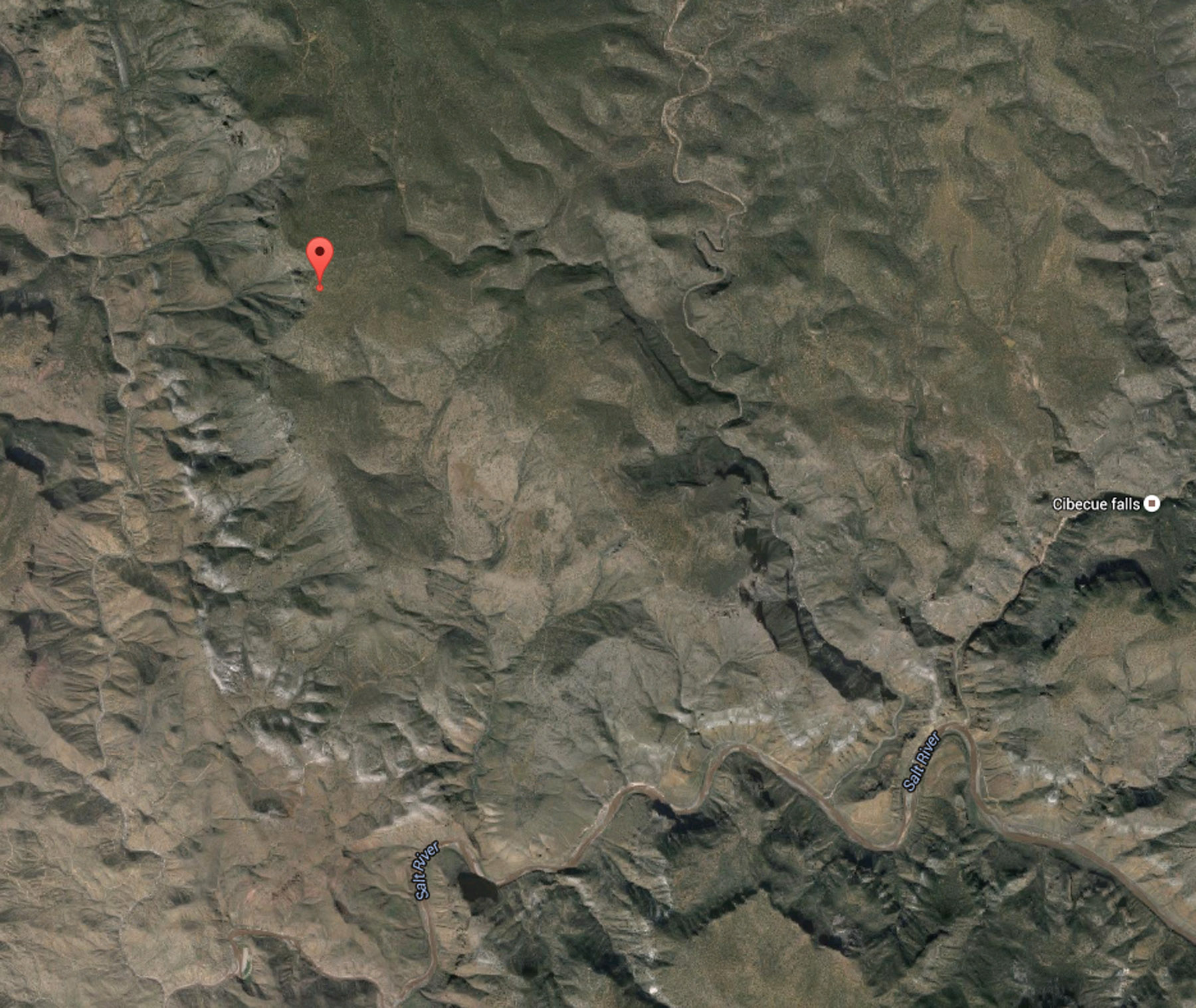
Area of strewn field in Fort Apache Reservation (west of Canyon Creek, north of Salt River) with fall location of the 29.35 g mass
The Apache tribal police does not allow private meteorite hunters enter their territory without permission and charges fine of up to several hundred dollars per person. Meteorite hunters who arrived in the potential fall area on 3 June had to pay fines of up to a few hundred dollars. On 11 June it was announced that the researchers of Arizona State University’s Center for Meteorite Studies have received special permission to search for meteorites on the tribal land of the White Mountain Apache. The strewn field in the mountainous desert area was calculated to be about 8 miles long and one mile wide.
Bolide recorded by Harold Wagstaff in Needles, California.
Bolide recorded by PhoenixfireScan
Bolide recorded with a dash cam by Mark Olhava on the I40 highway eastbound, ~ 33.6 km east of Kingsman, Arizona at location ~ 35°09’35.4″N, 113°41’13.6″W.
Bolide recorded by Ian Schlueter from Cooper road and the 202 in Chandler, Arizona
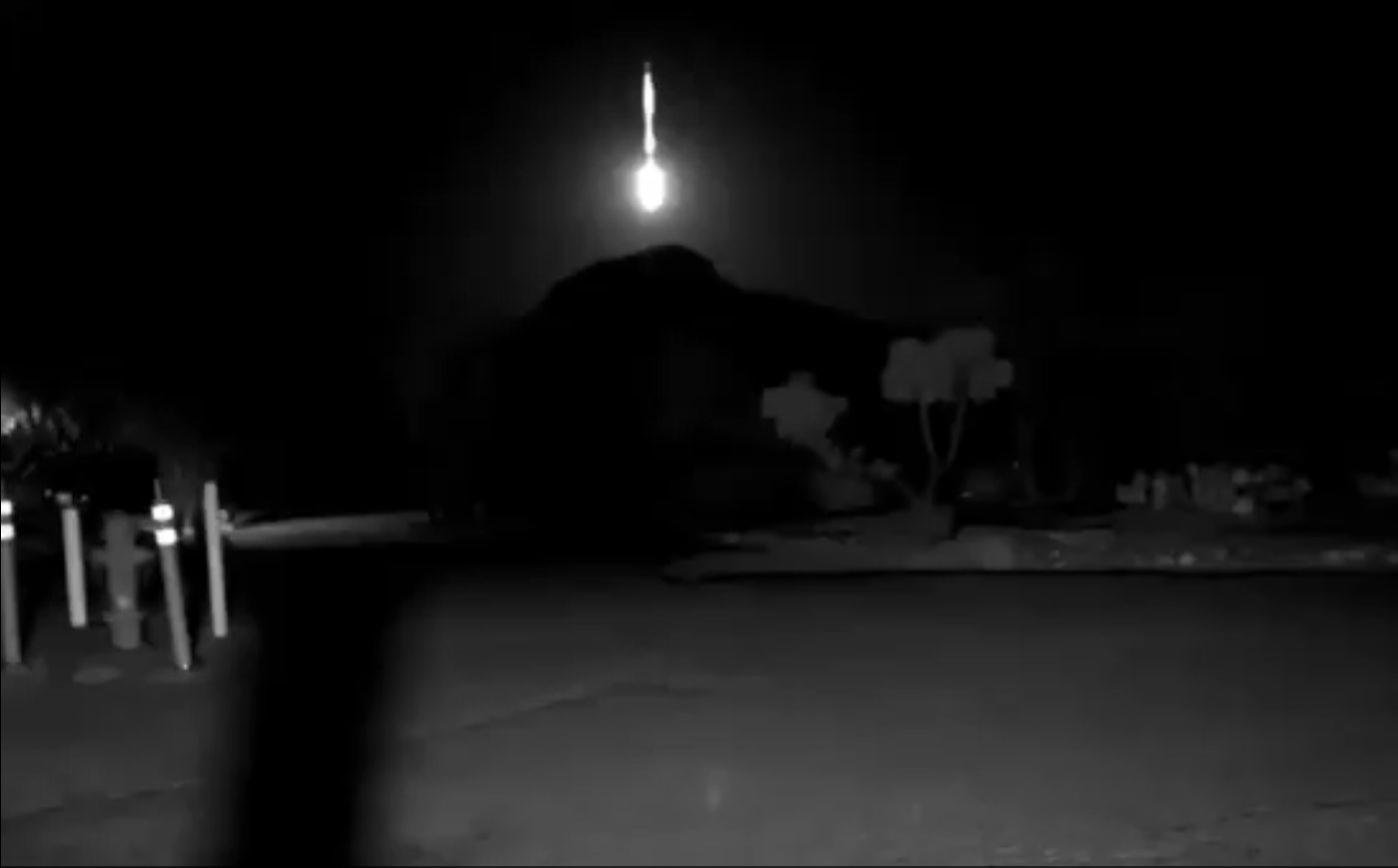
Bolide captured by security cam at Correctional Officer Academy in Tucson (32.240564, -111.084164 5601 W Trails End Rd, Tucson AZ 85745) — CLICK IMAGE TO VIEW VIDEO !

Beginning of luminous trail (centre of circle) recorded at Turkey Spring Observatory, Payson, AZ (34.233257, -111.300560) at 10-56-28.340 UTC / Image: SkySentinel, LLC
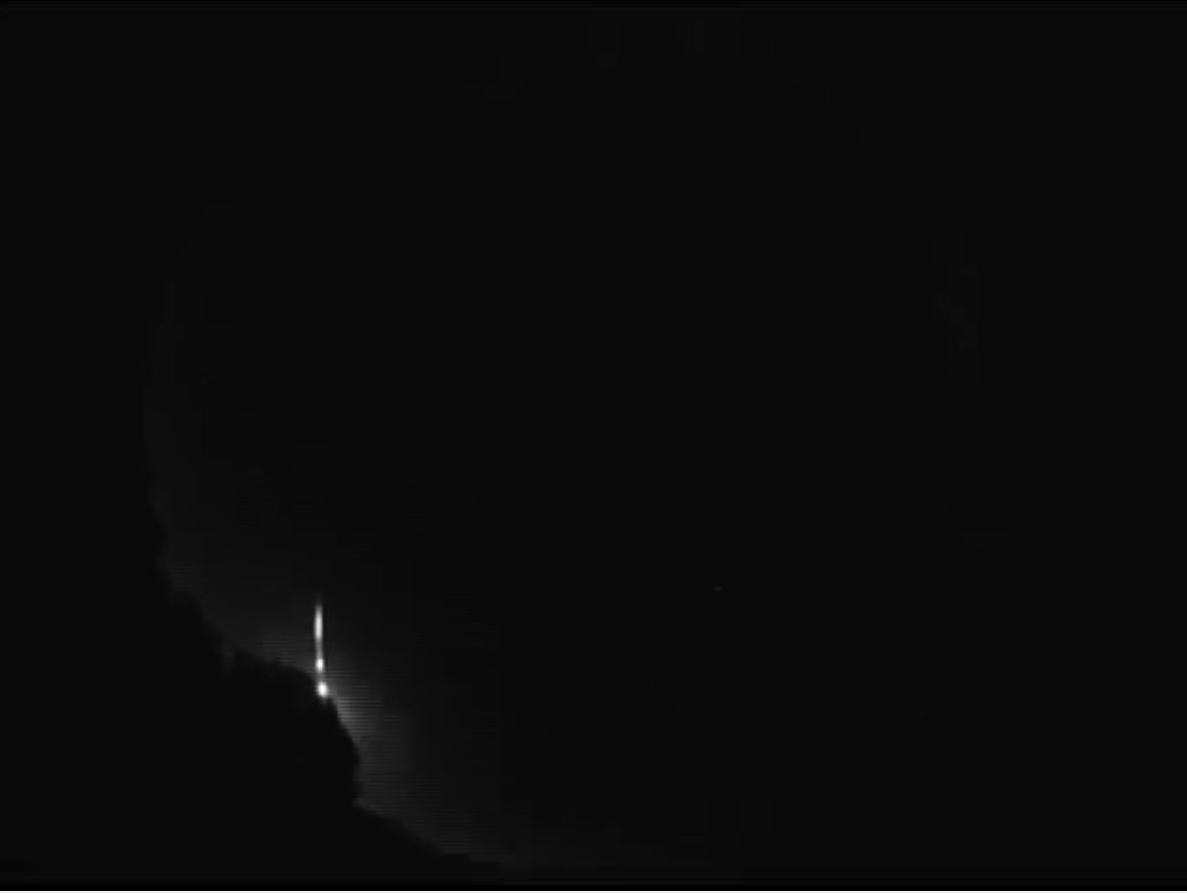
Luminous trail (partly hidden by tree) recorded at Turkey Spring Observatory, Payson, AZ (34.233257, -111.300560) / Image: SkySentinel, LLC
Bolide recorded at Turkey Spring Observatory, Payson, AZ (34.233257, -111.300560) between 10:56:28.340 UTC and 10:56:35.812 UTC / Video: SkySentinel, LLC
Scientific literature
Orbit and origin of the LL7 chondrite Dishchii’bikoh (Arizona)
Peter Jenniskens, Nick Moskovitz, Laurence A. J. Garvie, Qing‐Zhu Yin, J. Andreas Howell, Dwayne L. Free, Jim Albers, David Samuels, Marc D. Fries, Prajkta Mane, Daniel R. Dunlap, Karen Ziegler, Matthew E. Sanborn, Qin Zhou, Qiu‐Li Li, Xian‐Hua Li, Yu Liu, Guo‐Qiang Tang, Kees C. Welten, Marc W. Caffee, Henner Busemann, Matthias M. M. Meier, David Nesvorny
Meteoritics & Planetary Science
First Published: 9 March 2020
Analysis of June 2, 2016 bolide event over Arizona
Csaba Palotai, Ramanakumar Sankar, Dwayne L. Free, J. Andreas Howell, Elena Botella,Daniel Batcheldor
accepted for publication in MNRAS, last revised (v2) 21 May 2019
“On June 2, 2016 at 10h56m UTC, a−20.4±0.2 magnitude superbolide was observed over Arizona. Fragments were located a few days later and the meteorites were given the name Dishchii’bikoh. We present analysis of this event based on 3 cameras and a multi-spectral sensor observations by the SkySentinel continuous fireball-monitoring camera network, supplemented by a dash cam footage and a fragmentation model. The bolide began its luminous flight at an altitude of 100.2±0.4km at coordinates φ=34.555±0.002°N planetographic latitude and λ=110.459±0.002°W longitude, andit had a pre-atmospheric velocity of 17.4±0.3km/s. The calculated orbital parameters indicate that the meteoroid did not belong to any presently known asteroid family. From our calculations, the impacting object had an initial mass of14.8±1.7 metric tonnes with an estimated initial diameter of 2.03±0.12m.”
MEDIA COVERAGE
ABC 15, Arizona (2 June 2017)
Interview with Laurence Garvie
(kjzz, 31 May 2017)
AUDIO (MP3)
Click image to start video.
(Video: Ken Fagan/ASU Now, 1 June 2017)
Tracking down the Arizona fireball (ASU Now, 28 June 2016)
ASU scientists recover meteorites in remote Arizona desert
11 June 2016 / Video: KPHO/KTVK (KPHO Broadcasting Corporation)

